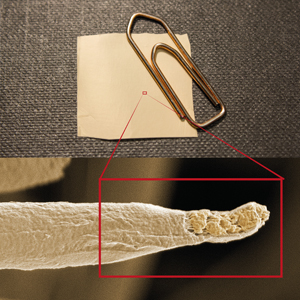Oct 1 2014
Researchers at the KTH Royal Institute of Technology have developed safe, antibacterial fibres using bio-compatible plastics and lanosol, an antimicrobial compound found in red algae seaweeds. Silver ions are widely used in odor-free and antibacterial clothing, and the safety of these materials has been widely debated.
 A close-up of the antibacterial fibre created by the KTH scientists. In this 2x2cm swatch of fabric are nearly 200,000 threads running in the same direction.
A close-up of the antibacterial fibre created by the KTH scientists. In this 2x2cm swatch of fabric are nearly 200,000 threads running in the same direction.
The study was conducted by Mikael Hedenqvist, a professor of polymer materials; Richard Olsson, an assistant professor; and Rickard Andersson, a doctoral student, all of them belonging to the KTH Royal Institute of Technology.
The national agency for chemical inspection in Sweden has ruled that silver is a risk to health and could potentially affect genetic material, embryonic development and reproduction in humans.
Silver ions have been used for particle-based antibacterials for clothing, and the newly developed material is a safe alternative to these ion-based materials. The researchers used electrospinning and created an ultra-thin thread, whose thickness was just 1/100th of a normal human hair. The extreme thinness enabled better contact with the surrounding area and improved cleaning of the bacteria.
When antibacterial particles such as silver are used, the fibres clump together. However, when the ultra-thin thread is integrated with lanasol, no clumping occurs. This allows the ultra-thin thread to be used in standard structures in which the strands run in a single direction and also in non-woven materials and other such random network structures. The even distribution of the substance in the thread and its solubility are a distinct advantage.
The antiseptic substance derived from red algae has demonstrated potential to kill 99.99% of Staphylococcus aureus bacteria. This bacteria has been found to cause wound and skin-related infections in hospitals. Due to this property, the new material holds promise for dress fittings and air filters in hospitals.